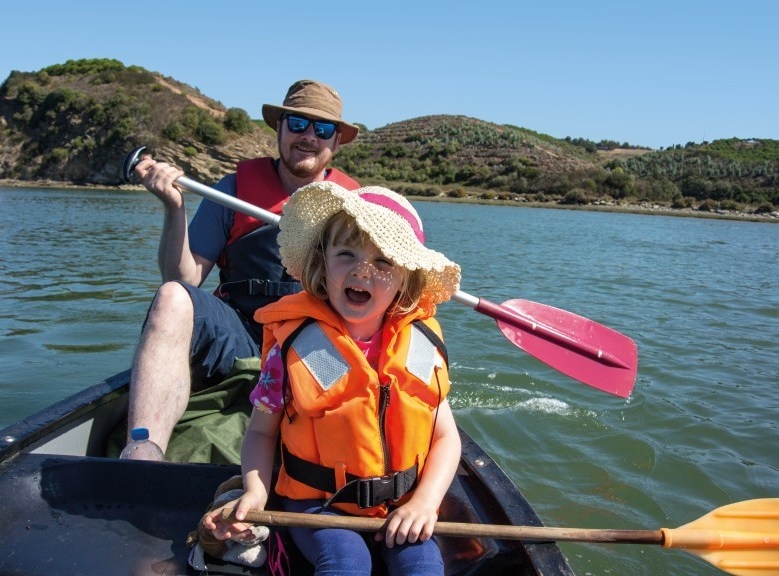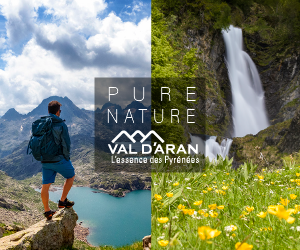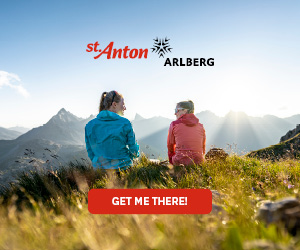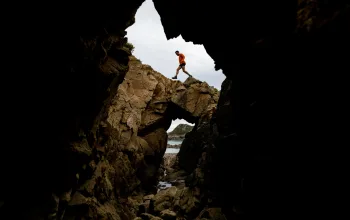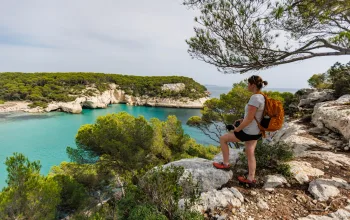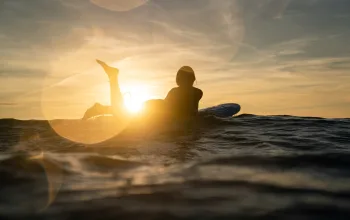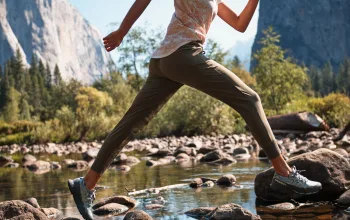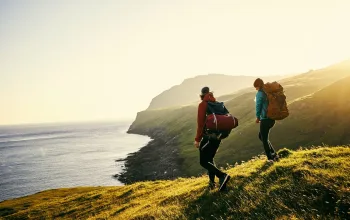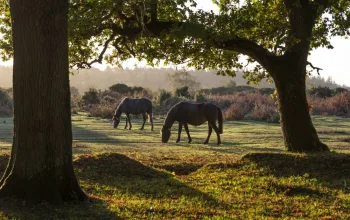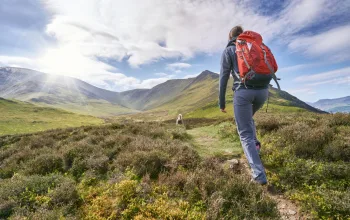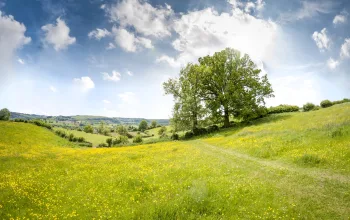My wife, Issy’s face has just dropped and she’s staring at the vast Mira river in front of us. “You’re really not coming?” she asks our ‘guide’. We’re in the picturesque port of Vila Nova de Milfontes, about to set off for our 9km canoe adventure and we’re being given instructions to go it alone... “Don’t go to the right under the bridge – the current will suck you over to the sand banks and you’ll get stuck. Watch out for the jelly fish 3km in. Don’t get out where there is quick sand…” Evidently when I said we were going on a canoe adventure Issy had assumed it wouldn’t be adventurous at all!
This is day two of the first leg of our trip to the Alentejo region of Portugal on a multi-activity holiday tailored to Libby, our energetic three-year old, and our love of Portuguese food and wine. We’ve designed our trip to have a family-friendly activity every morning, followed by lunch at recommended restaurants, and free afternoons relaxing at our accommodation around the pool or on the beach. The theory behind this is that adventures with very young children are best in the morning – whereas those in the afternoon when tiredness has set in can be disastrous.
After some re-assurance for Issy and some coaxing for Libby to get into her life jacket, we shuffle the canoe down the stony bank of the river and stop for some photos before setting off on our journey. It’s a beautiful sunny September day and within ten minutes we’re out of the busier port and winding our way on the current surrounded by stunning scenery, fantastically relaxed. Not for long though. Libby hasn’t quite grasped the importance of staying still in a boat, and when she sees a crab floating in the water she leaps up and turns to tell me about it – I just catch her in time before we all get very wet! She’s loving every minute though, holding her own mini paddle so she feels involved. We continue to meander, seeing some of the markers we were told about on the way so we know how far we’ve come. We spot the jelly fish too – dozens of them and Libby is instructed to stay put.
The trip is around four hours in total, ending in Casa Branca, a former shipment port for wheat and olives, which is abandoned today but after an hour and a half Libby has reached her sitting still limit. So we stop in a nice cove with dappled shade to shelter from the now blazing hot sunshine and search for crabs with the net we’ve been given. There are sea birds and other wildlife everywhere to keep us entertained. Back in the boat, the rowing is made easier by an increasingly strong wind from the sea. There is always a real sense of adventure and freedom to being on the water, and covering distance under our own steam gives us a strong sense of shared family achievement we rarely get to experience when doing activities with Libby.
Our reward is a round of cooling ice creams on the staggeringly beautiful beach at Vila Nova where we paddle in the warm shallows of the sea while the sun slowly sets.
The canoe adventure is part of the first leg of our week, based at the excellent and extremely family friendly Monte do Giestal in Abela, a small, pretty and tourist-free village 15km from the western Alentejo Coast and about 170km from Lisbon.
The coastline of this region is spectacular with beautiful hidden beaches sheltered by sheer cliffs, and quiet fishing villages and towns that, for the most part, have been developed tastefully. The Alentejo is known as the place where the Portuguese go on holiday, with a fraction of the visitors from the UK that the Algarve gets. This shows everywhere – in-fact we don’t meet a single English family on the whole trip.
With coastline squaring up to the Atlantic swells, the surfing is world class here too, and during our one free day on the beach, mesmerized by the perfect waves and glistening sea, I can’t resist taking a lesson with Costazul Surf School in São Torpes. From the beach the waves look about my level (small!) but appearances can be deceiving and I spend most of the lesson regretting telling the instructor I have some experience, their power repeatedly flipping me face first into the wash. I’m not sure when I will graduate from total beginner to anything like capable but after ten lessons I’m still awful. Spreading those lessons over 15 years is probably where I’m going wrong! The one wave I do catch properly makes it all worthwhile though, and just being in the water in such a location is a pleasure.
On the final morning of our stay at the Monte go Giestal we spend a lovely few hours cycling around the cork tree-forested 71 hectare estate. The dirt tracks are perfect for family riding and there is not a car in sight – in-fact it’s utterly tranquil with only the wind in the trees, horses and birdsong to break the peace. Stopping under the shade of a giant cork tree for a picnic on a fallen tree trunk we all agree we’ll leave with a heavy heart.
Pushing inland
The next day we leave the coast behind and head to our second base, Monte da Serralheira, just outside the walled city of Evora, the capital of Alentejo and a UNESCO World Heritage site with its Roman temple and an abundance of historical buildings. Our heavy hearts are lifted instantly on arrival with the effervescent Lucia welcoming us with the kind of home-made lemonade that makes your ears tingle and traditional cakes. Lucia and her husband, George, came to Portugal from the Netherlands to start a farm 30 years ago and have been here ever since. A guide in her own right, Lucia suggests the best way to explore the almost traffic-free Evora is by bike, so we arrange a guide for the next morning to tour its palaces, picturesque squares and narrow cobbled streets.
Waking to another stunning blue sky day and with directions in hand, we head off in the car to collect our bikes and meet our guide from Turaventur. What nobody has mentioned was never to enter Evora’s walls by car if you don’t know what you’re doing. After winding our way round the one-way system through some incredibly narrow streets and a few ‘wrong way’ streets we have absolutely no idea where we are and can’t escape. Admitting defeat and now an hour late, I pop into a car dealer to ask directions. His face says it all. Scratching his chin and shaking his head he tells me the only way we’ll ever get there is if he gets in the car and comes with us.
By the time we’re on the bikes, the sun has heated the day and we’re glad of the shade from the buildings. Soon after we set off, we meander into the main square and notice a group of older Portuguese queuing up to take turns checking a message board. According to our guide they are looking to see if they are dead! It seems that once locals who had passed away were listed here and so black humour led to the tradition of checking if your own name was listed!
Touring the often steep cobbled streets, we passed little shops selling local pottery and fabrics, Roman ruins and various sculptures and modern art that give Evora an arty and cosmopolitan feel to go with its history. But then we saw proof of what was either more black humour or simply impressive pragmatism. Definitely the most remarkable site in Evora is the Bones Chapel, built in the 16th century by a Franciscan monk using approximately 5,000 skeletons from overcrowded burial grounds, the walls are inlaid with real bones and skulls and the welcome message at the entrance reads ‘Nos Ossos que aqui estamos pelos vossos esperamos’ translating to ‘We bones that are here, we are waiting for yours’! It’s strange, beautiful and hugely thought provoking at the same time but we both flounder when Libby asks what they are made of!
After the steep hills of Evora our aching thighs are relieved to hit the flat. We wind our way downhill out of the walled city for a two-hour ride through its rural surroundings, following one of the many ‘ecotrails’ that can be found throughout the Alentejo. Mostly traffic-free, these routes are easy to follow and perfect for families with a mix of flat and wide dirt tracks and low-traffic tarmac roads that wind through farmland. Although the fields and hedgerows on our ride are dry and barren following a long, hot summer, you can imagine cycling here in spring would be full of vibrant smells and flora.
Picture perfect
Outside Evora the following day we find more history at Monsaraz, this time by horse chariot from the Horta da Moura hotel. Monsaraz is a picture-perfect hilltop village with spectacular views from its battlements across sun-baked fields towards the Guadiana river – the border with Spain. You can really feel the historical significance of this place, which was originally fortified by the Knights Templar, its far-reaching views perfect for spotting invaders. The picturesque cobbled streets are traffic-free during the day creating a feeling of calm and tranquillity that has clearly not always been the case through Portugal’s turbulent history.
From Monsaraz the immediate view is dominated by the enormous Alqueva Lake – the largest manmade lake in Europe. And that is the destination for our final adventure.
On the morning of our departure we head to Amieira Marina to take a house boat for half a day, stopping in coves to explore the hiking paths. The house boats are normally taken for multiple-day excursions to explore the vast expanse of water and the many adventures waiting on its banks. Our whirlwind tour shows us canoeing, hiking and biking trails, and plenty of small towns to visit, really whetting our appetite for a completely different way to explore the Alentejo.
Drifting back to the marina to hand back our house boat before our final transfer to the airport, gives us the chance to reflect on the week. The Alentejo has delivered exactly what we were looking for: gentle but adventurous and interesting family activities, plus culture, history, food, wine and a real feeling of authenticity which you wouldn’t get in some of the more well-known Portuguese tourist hotspots. We’d recommend the Alentejo wholeheartedly for families of all ages… and the wine and food exceeds all expectations too!


